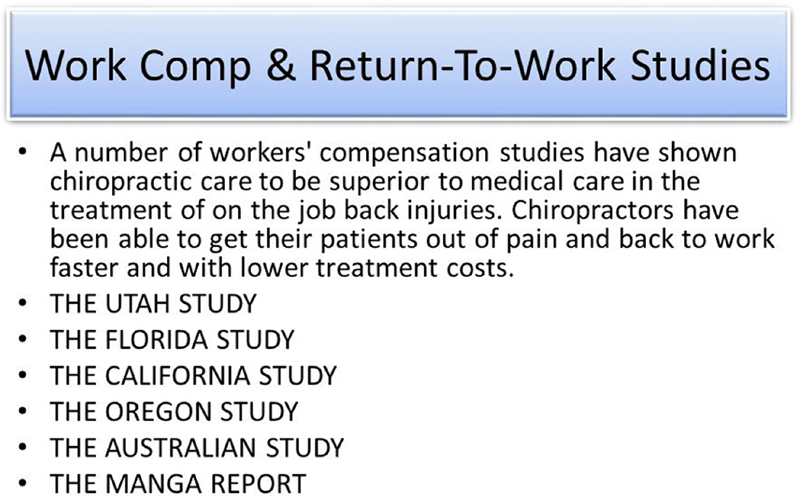Factors Affecting Return To Work After Injury Or Illness: Best Evidence Synthesis of Systematic Reviews
SOURCE: Chiropractic & Manual Therapies 2016 (Sep 8)
Carol Cancelliere, James Donovan,
Mette Jensen Stochkendahl, Melissa Biscardi,
Carlo Ammendolia, Corrie Myburgh and J. David Cassidy
Institute of Health Policy,
Management and Evaluation,
Dalla Lana School of Public Health,
University of Toronto,
Toronto, Ontario Canada
BACKGROUND: Work disability is a major personal, financial and public health burden. Predicting future work success is a major focus of research.
OBJECTIVES: To identify common prognostic factors for return-to-work across different health and injury conditions and to describe their association with return-to-work outcomes.
METHODS: Medline, Embase, PsychINFO, Cinahl, and Cochrane Database of Systematic Reviews and the grey literature were searched from January 1, 2004 to September 1, 2013. Systematic reviews addressing return-to-work in various conditions and injuries were selected. Eligible studies were critically appraised using the Scottish Intercollegiate Guidelines Network criteria to identify low risk of bias reviews.
RESULTS: Of the 36,193 titles screened and the 94 eligible studies reviewed, 56 systematic reviews were accepted as low risk of bias. Over half of these focused on musculoskeletal disorders, which were primarily spine related (e.g., neck and low back pain). The other half of studies assessed workers with mental health or cardiovascular conditions, stroke, cancer, multiple sclerosis or other non-specified health conditions. Many factors have been assessed, but few consistently across conditions. Common factors associated with positive return-to-work outcomes were higher education and socioeconomic status, higher self-efficacy and optimistic expectations for recovery and return-to-work, lower severity of the injury/illness, return-to-work coordination, and multidisciplinary interventions that include the workplace and stakeholders. Common factors associated with negative return-to-work outcomes were older age, being female, higher pain or disability, depression, higher physical work demands, previous sick leave and unemployment, and activity limitations.
There are more articles like this @ our:
CONCLUSIONS: Expectations of recovery and return-to-work, pain and disability levels, depression, workplace factors, and access to multidisciplinary resources are important modifiable factors in progressing return-to-work across health and injury conditions. Employers, healthcare providers and other stakeholders can use this information to facilitate return-to-work for injured/ill workers regardless of the specific injury or illness. Future studies should investigate novel interventions, and other factors that may be common across health conditions.
KEYWORDS: Absenteeism; Intervention; Presenteeism; Prognosis; Return to work; Sick leave; Work disability
From the FULL TEXT Article
Introduction
Work disability is a major personal, financial and public health burden. [1] Annual productivity losses from missed workdays due to low back pain (LBP) are estimated at $28 billion in the United States alone [2] and LBP is now the leading cause of disability, affecting nearly 600 million people worldwide. [3] In addition to musculoskeletal disorders (MSKDs) [3, 4], disability from cardiovascular disease [5], cancer survivorship [6] and mental health disorders [7] are also increasing. With more people living with many types of chronic illnesses now than ever before, the problem of work disability will continue to escalate if we do not take action. [8] Return to work (RTW) is a major indicator of real-world functioning; thus, predicting future work success is a major focus of research. [9] Individuals unable to RTW due to an injury or illness can experience greater physical ailments, as well as poorer psychosocial adjustment (i.e., increased anxiety, depression, social isolation). [10, 11] The consequences studied in those exposed to sick leave include inactivity and isolation, suicide, decreased career opportunities, and decreased personal finances. [12] The consequences studied in those exposed to disability pension include reduced quality of life and self-reported health, and increased health service utilisation and substance abuse. [12] Improving return to work (RTW) outcomes is therefore critical.
Most of the RTW literature has focussed on MSKDs, especially LBP. “Seven principles for successful RTW” have previously been established for MSKDs by the Institute of Work and Health in 2007 [13]:
(1) the workplace has a strong commitment to health and safety
(2) work accommodation
(3) support the returning worker without disadvantaging co-workers and supervisors
(4) supervisors are trained in work disability prevention and included in RTW planning
(5) the employer makes early and considerate contact with injured/ill workers
(6) RTW coordination, and
(7) employers and healthcare providers communicate with each other about the workplace demands.
These guidelines were intended for all workplaces and RTW professionals. Additionally, Briand et al. [14] synthesized systematic reviews of RTW interventions for MSKDs up to 2006. They indicated that the essential components of RTW interventions are centralized coordination of the worker’s RTW, formal individual psychological and occupational interventions, workplace based interventions, work accommodations, and contact between the various stakeholders and interventions.
Many of these factors are closely related to the environment and workplace, and it is likely that these prognostic factors are not unique to MSKDs. As such, rather than investigating RTW prognostic factors for a multitude of different health conditions, there is a need to understand the common factors that determine RTW across these conditions.
Read the rest of this Full Text article now!





Leave A Comment